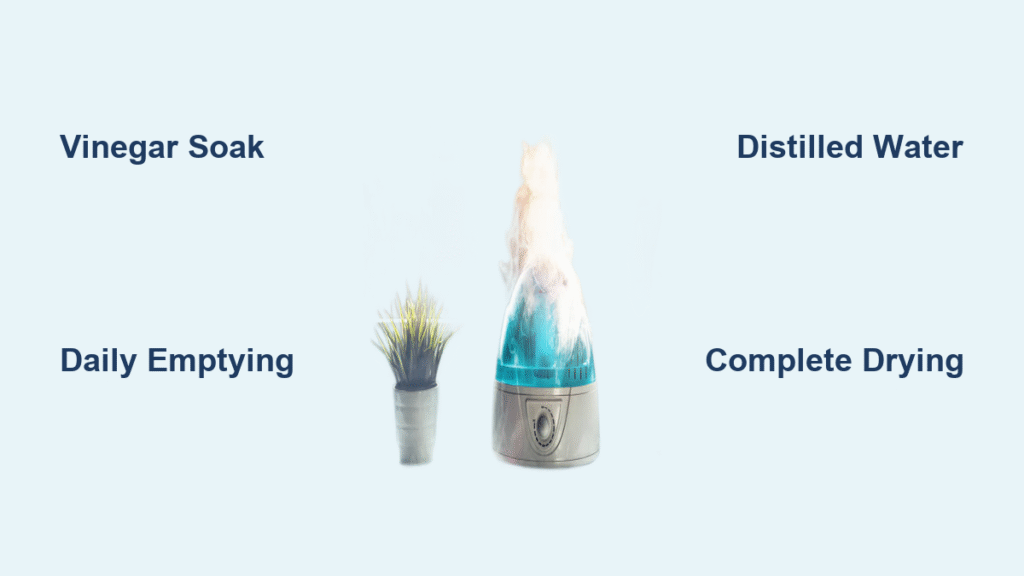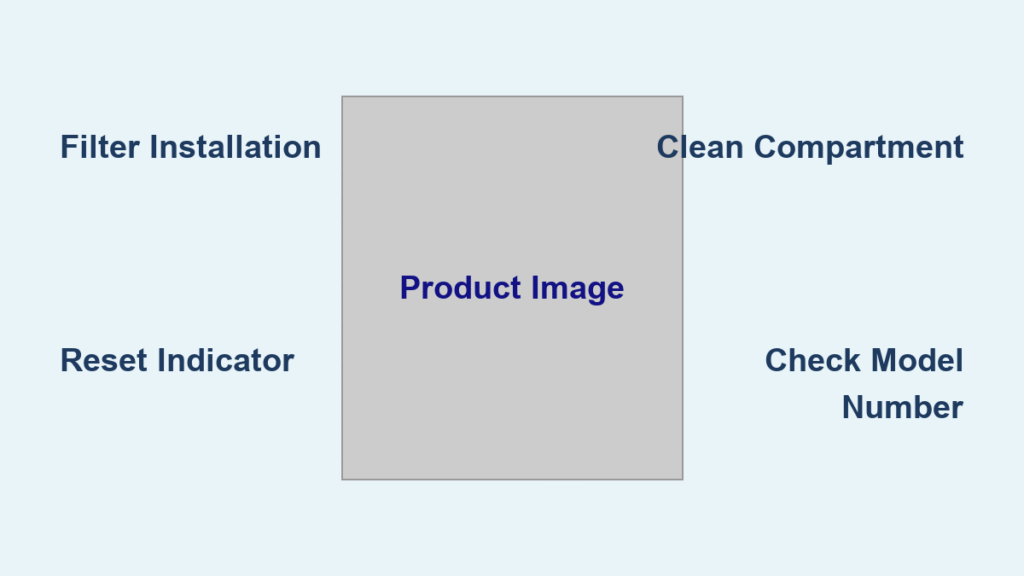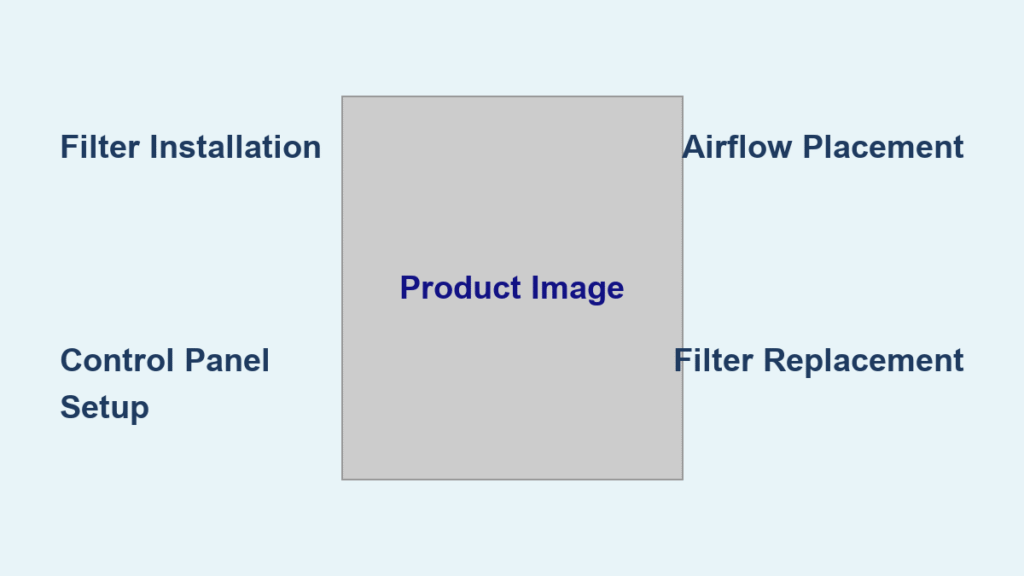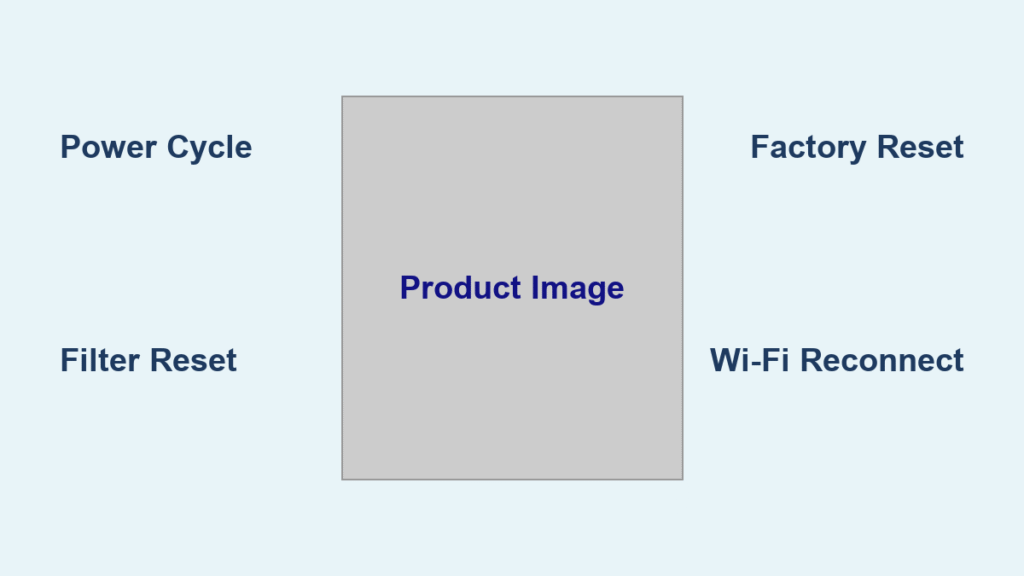That sharp musty smell hitting your face when you turn on your humidifier? It means mold has invaded your unit. Fuzzy black, green, or pink spots coating the tank walls transform your air-quality ally into a health hazard overnight. Left unchecked, every mist cycle pumps spores into your breathing space—triggering allergies, asthma flare-ups, or respiratory irritation. If you’ve ever wondered how to clean humidifier mold effectively while preventing its return, this guide delivers actionable steps verified by manufacturer protocols. You’ll eliminate contamination in under an hour and build habits that keep your humidifier mold-free for good.
Why Mold Grows in Humidifiers
Your humidifier isn’t just adding moisture—it’s creating a perfect breeding ground. Stagnant water combined with warm temperatures and mineral deposits from tap water lets airborne mold spores multiply explosively. Within 48 hours, colonies form on damp surfaces, releasing thousands of new spores into your air with every use. Tap water accelerates this process: minerals like calcium feed bacterial growth, while infrequent cleaning allows biofilm (a slimy protective layer) to anchor mold deep in crevices. Leaving water in the tank overnight or storing a damp unit in a dark closet guarantees contamination.
Key triggers for rapid mold growth:
– Water sitting stagnant for 24+ hours
– Using tap water instead of distilled (minerals = mold food)
– Skipping weekly cleaning for more than 7 days
– Storing the unit with residual moisture inside
– Warm, enclosed storage spaces (like bathroom cabinets)
Spot Mold Before It Spreads
Catching contamination early prevents health risks and intensive scrubbing. Inspect your humidifier weekly using these field-tested indicators:
Visual red flags:
– Black/green fuzzy patches in tank corners or under the waterline
– Pink slime (Serratia marcescens bacteria) on base surfaces
– Cloudy water that won’t clear after rinsing
– Discolored rings around mist outlets or water inlets
Critical warning signs:
– Musty odor only when the unit runs (spores aerosolizing)
– New allergy symptoms like sneezing or itchy eyes during use
– Respiratory tightness in asthmatics within 30 minutes of operation
– White mineral dust settling on furniture (sign of mold-feeding scale)
Essential Cleaning Supplies Checklist
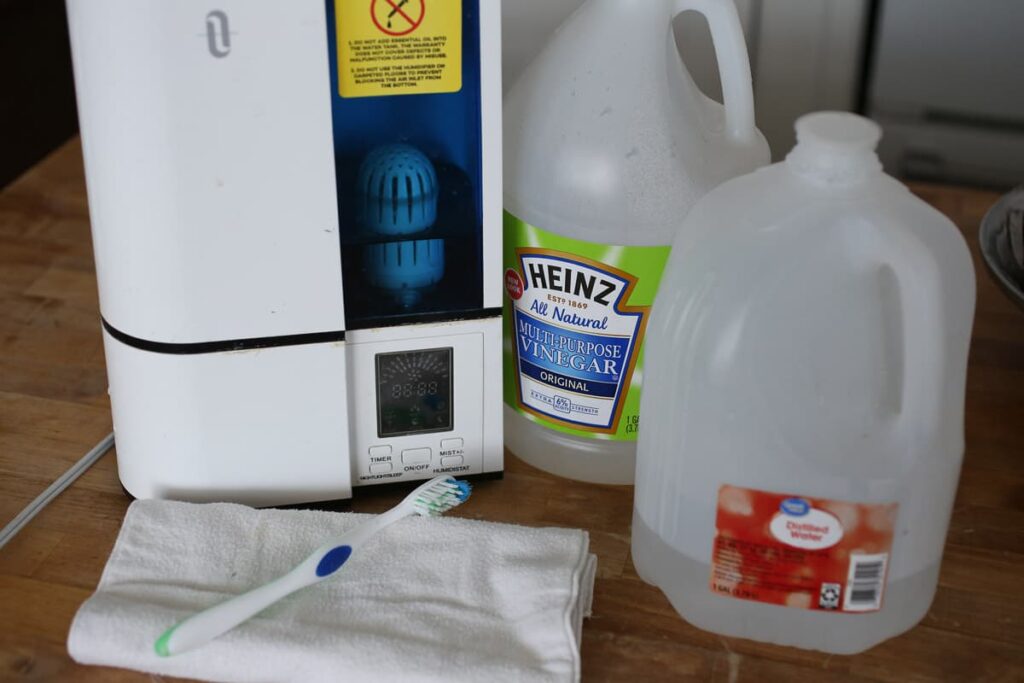
Gather these items before disassembly to avoid mid-cleaning delays:
Core cleaning kit:
– Distilled white vinegar (undiluted for active mold; 1:1 ratio for maintenance)
– Liquid chlorine bleach (1 tsp per gallon water) OR 3% hydrogen peroxide
– Soft-bristle brush (nylon dish brush or old toothbrush for crevices)
– Microfiber cloths (lint-free for final wipe-downs)
– Cotton swabs for nozzle valves and narrow tubes
– Measuring cup (for precise bleach dilution)
Non-negotiable safety steps:
– Never mix bleach + vinegar—creates toxic chlorine gas
– Work outdoors or near open windows when using bleach
– Keep electrical components bone-dry (no submerging motors)
– Wear nitrile gloves if you have sensitive skin
Disassemble and Initial Rinse
Start with complete disassembly to access hidden mold pockets:
- Unplug the unit and carry components to a sink
- Remove water tank, base reservoir, mist nozzle, and filters
- Pour out all standing water—never reuse contaminated water
- Rinse each part under warm running water to flush loose debris
- Separate removable caps, seals, and internal valves
Pro tip: Snap a photo of your disassembled unit before cleaning. Humidifier parts often have tricky reassembly sequences—this saves 10+ minutes of frustration later.
Vinegar Treatment for Mold Removal
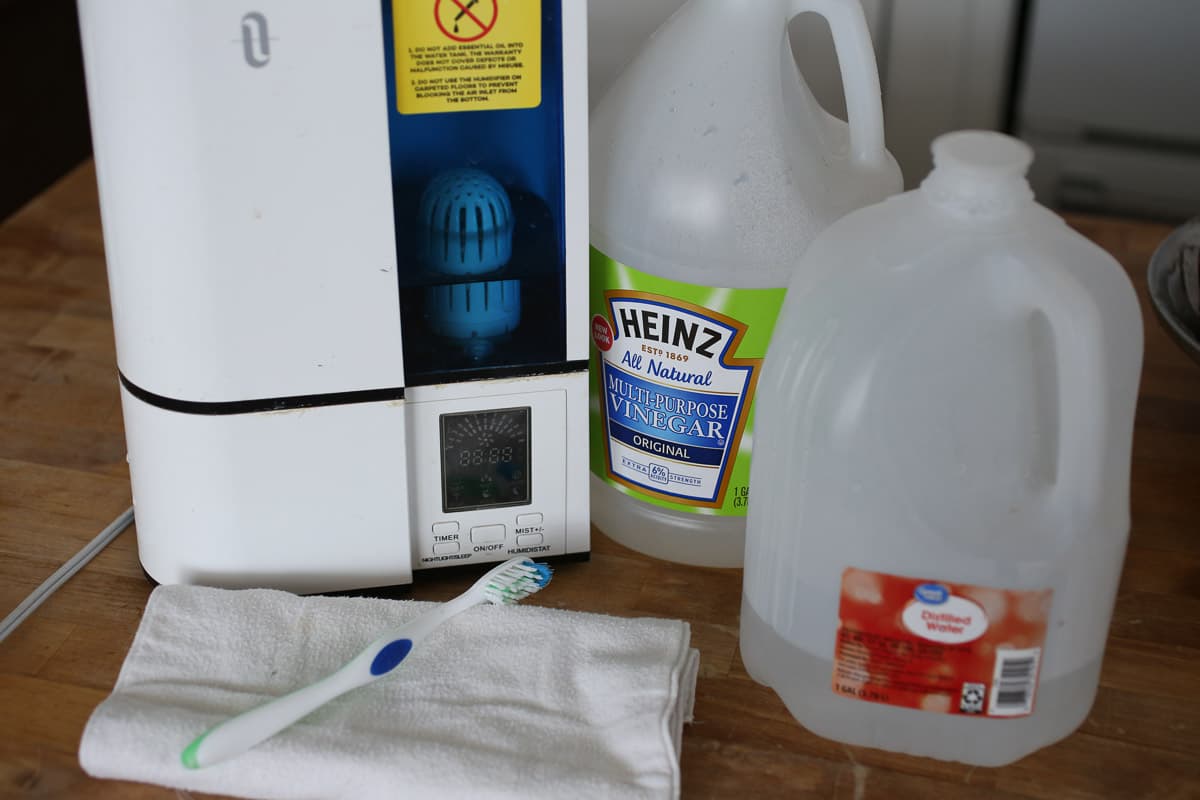
White vinegar dissolves 82% of mold species while breaking down mineral scale. This is your frontline defense for active contamination:
Tank soaking protocol:
– Fill the tank completely with undiluted vinegar
– Let stand 1–4 hours (4 hours for severe cases; 1 hour for light pink slime)
– Swirl gently every 30 minutes to coat all surfaces
– Focus on corners where water pools and under the waterline
Small parts deep clean:
– Submerge the base reservoir and detachable valves in vinegar
– Soak 30–60 minutes—minerals soften, releasing trapped mold
– Scrub mist channels with a toothbrush dipped in vinegar
– Use cotton swabs for nozzle valves (replace swabs if they turn black)
Critical rinse step:
– Empty vinegar completely
– Rinse each component under running water for 60+ seconds
– Stop rinsing only when vinegar odor disappears—residual acid irritates lungs when aerosolized
Disinfect After Heavy Contamination

Monthly deep cleans or severe mold outbreaks require spore-killing disinfection:
Bleach method (for plastic/metal parts):
– Mix 1 teaspoon bleach per gallon of cool water
– Fill tank/base with solution; soak 15–20 minutes
– Scrub surfaces while solution works (don’t let it dry)
– Rinse until bleach odor is 100% gone (test by sniffing close to parts)
Hydrogen peroxide alternative (safer for frequent use):
– Use undiluted 3% hydrogen peroxide same as bleach method
– Less corrosive to plastic components than bleach
– Equally effective against mold spores
– No toxic fumes—safe for indoor use
Warning: Always run bleach disinfection cycles outdoors. Fumes trapped indoors can trigger respiratory distress.
Dry Completely Before Reassembly
Moisture in hidden crevices reignites mold growth within days. Follow these drying protocols:
Air-drying best practices:
– Place parts in direct sunlight for UV sterilization (20+ minutes)
– Position components vertically so water drains from channels
– Blot interiors with paper towels—never leave wet spots
– Check hidden areas with a dry finger (e.g., under seals)
Dryness verification test:
Run the unit with fresh distilled water for 15 minutes. Bubbles or chemical odors mean incomplete rinsing—repeat cleaning. True dryness shows zero residue after this test.
Daily Prevention Habits
Stop mold before it starts with these 90-second routines:
After every use:
– Empty the tank completely—don’t let water sit overnight
– Shake out droplets by inverting the tank for 10 seconds
– Store tank cap-off to prevent trapped moisture
– Wipe the base with a dry microfiber cloth
Water quality rules:
– Always use distilled or demineralized water (tap water = mold food)
– Avoid “humidifier additives”—they corrode parts and aerosolize chemicals
– Consider a reverse osmosis (RO) system for cost-effective pure water
Cleaning by Humidifier Type

Tailor your approach to your unit’s design:
Ultrasonic/Cool Mist Units
- Never add vinegar/bleach to tank water—aerosolizes into breathable air
- Clean ultrasonic disks monthly with vinegar-soaked cloth (no scrubbing)
- Replace mineral-clogged disks if mist output weakens
Evaporative/Wick Models
- Rinse wicks under cold water weekly—never use bleach (degrades antimicrobial coating)
- Replace filters every 3 months—mold grows inside porous fibers
- Run unit dry for 1 hour after use to evaporate residual moisture
Warm Mist/Steam Vaporizers
- Descale heating elements monthly with vinegar soak (mineral buildup traps mold)
- Empty daily—stagnant water breeds bacteria faster in warm units
- Clean steam vents with cotton swabs after each deep clean
Troubleshooting Persistent Problems
When mold returns despite cleaning, target these hidden sources:
Recurring contamination fixes:
– Disassemble nozzle valves fully—soak in vinegar for 2 hours
– Replace scratched tanks—microscopic cracks harbor spores
– Check gaskets—remove and clean under seals with cotton swabs
Health-sensitive households:
– Clean twice weekly if anyone has asthma or allergies
– Use a UV-C sterilizer (built-in models only—aftermarket units are ineffective)
– Switch to warm mist—heat kills microbes before misting
Key Takeaway
Eliminating humidifier mold requires vinegar or peroxide for active removal plus distilled water and daily emptying for prevention. A 5-minute weekly rinse prevents 90% of outbreaks, while monthly disinfection stops hidden spores. Never compromise on drying—bone-dry parts are non-negotiable. Remember: your humidifier should refresh your air, not contaminate it. Start these habits today, and breathe easy knowing every mist cycle supports your health, not undermines it.

